Patti Stouter has been running a series of very interesting, even surprising, experiments with various materials that might be used to insulate earthbag walls. She has focused her attention on light-weight natural or recycled materials that can be bound together with a clay slip.
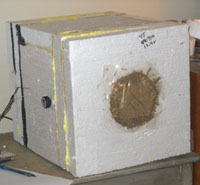 She devised a test apparatus to measure how well the materials impede the flow of heat, using a 4″ thick sealed beadboard box (15″ cube on outside) with a 6″ diameter opening on the top, where she packs her various materials to be sampled. A precision resistor attached to a regulated power supply heats the inside and there is a digital thermometer that reads in 1/10 of a degree F. When the inside of the box reaches a steady state she measures the difference between the temperature inside the box and the room temperature. She calibrated the device with some standard insulating materials with known R-values.
She devised a test apparatus to measure how well the materials impede the flow of heat, using a 4″ thick sealed beadboard box (15″ cube on outside) with a 6″ diameter opening on the top, where she packs her various materials to be sampled. A precision resistor attached to a regulated power supply heats the inside and there is a digital thermometer that reads in 1/10 of a degree F. When the inside of the box reaches a steady state she measures the difference between the temperature inside the box and the room temperature. She calibrated the device with some standard insulating materials with known R-values.
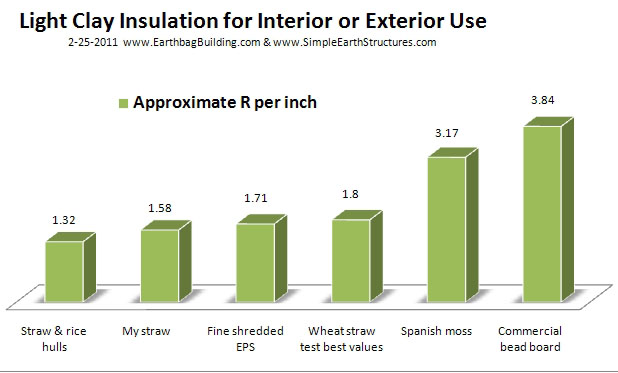
The above graphs illustrates the results of her experiments. Because both EPS packing peanuts and strips of grocery bags would emit toxic fumes if they burned, she has designated these for exterior use only. In actuality it is generally better to place any insulation materials on the exterior in order to isolate the thermal mass of packed soil on the inside. What is surprising is how extremely well some of these materials performed. Both Spanish moss and grocery bag strips measure at over R-3 per inch!
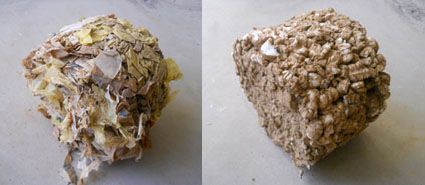
These test samples were made with a moderate strength silty clay, and materials might be stronger and lighter if made with a more plastic clay. The sample at right is made with the packing peanuts and the sample on the left are the grocery bag strips. Other possible light clay components are sea grass or eelgrass, coconut fibres, reeds, or mica.
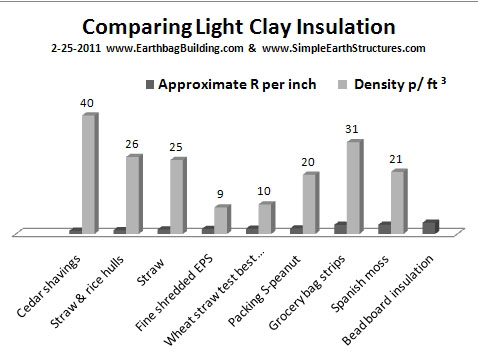 If you are interested in the density or weight of the various materials she used, the above graph shows this.
If you are interested in the density or weight of the various materials she used, the above graph shows this.

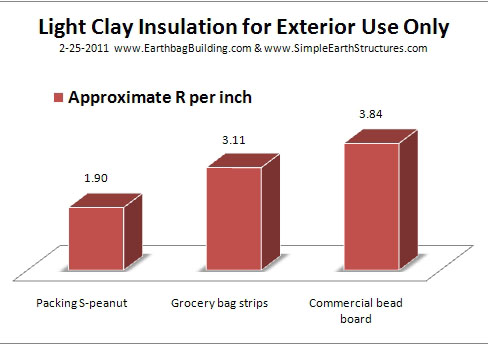
Are there any building projects where the bag strips or packing peanut in clay strips were used? If so, how did they fair? We’re making a walk-in freezer and are trying to use salvaged materials as much as possible. We have some beadboard scraps that could be ground up and put in a slip, but if plastic bags strips out perform the EPS to the degree that your testing shows, we may use that instead.
Contact Patti Stouter. She’s constantly innovating along these lines.
http://www.simpleearthstructures.com/
Also, I found a website recently that shows how to build walk in coolers using a standard window air conditioner. Are you familiar with that site? Even though the air conditioner is not large, it works because the walls are highly insulated. It seems hundreds of people have built them with good success.
Ok thank you I understand it better now. What a great use of those plastic bags! I’m assuming this is then meant to be stuffed inside poly bags? Or would it hold on the exterior wall without the bags to be covered with stucco mesh and then plaster?
This is useful information. I attempted to do something like it recently to test water bottles stuffed with plastic grocery bags but my testing procedures were unsuccessful. These are much more accurately done. Kudos! I am, however, confused by what “grocery bag strips” are and how they were added to the clay.
I have added another image in the blog post that shows the plastic grocery bag strips that were combined with the clay to form a test sample. You can see that there really isn’t much clay that holds it all together.
Would this also work with perlite and/or scoria. It may not add to the R value much but would it be worth while in making them more structurally stable when tamp down?
It depends on the application. Scoria, for instance, is stable enough on its own, and would have a higher R-value without the clay slip. Or maybe you have a post and beam design to stabilize the walls and so clay slip isn’t needed.